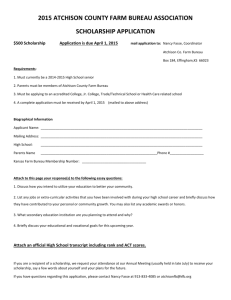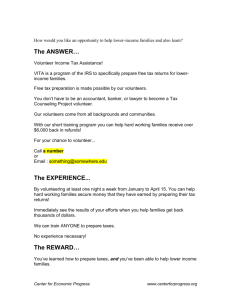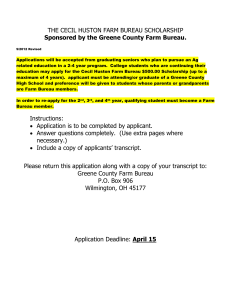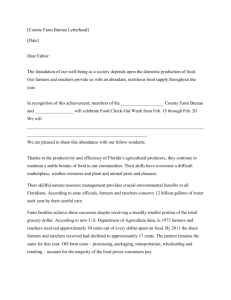Eric Kaufman, Ph.D., Hannah Carter, Ph.D., Rick Rudd, Ph.D.
advertisement
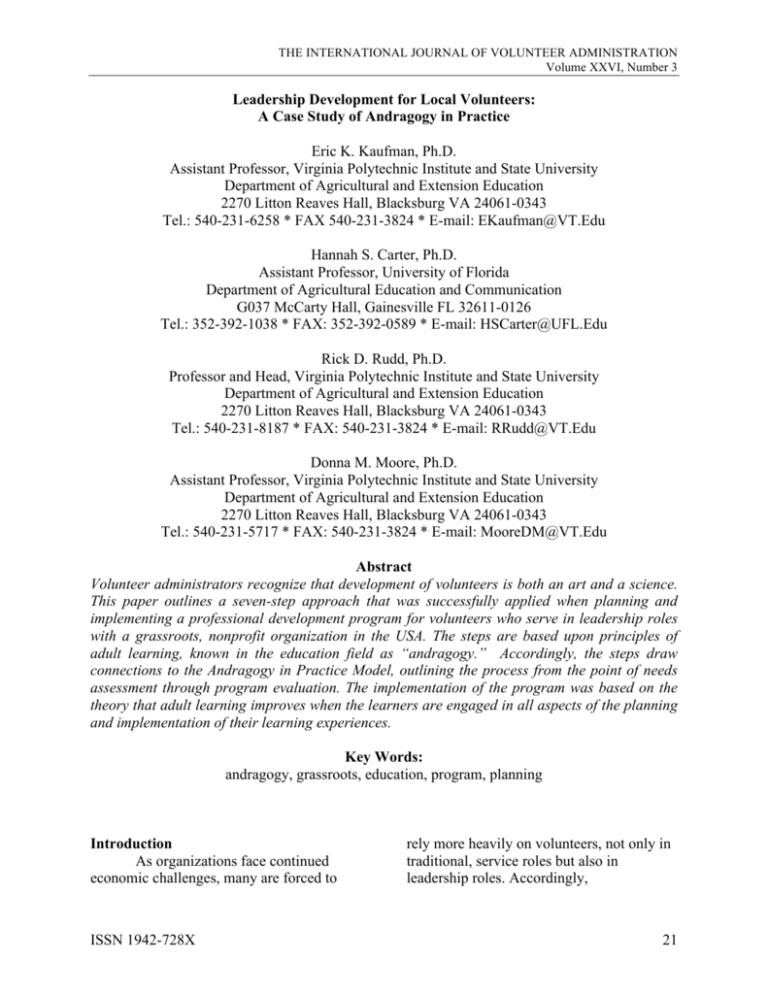
THE INTERNATIONAL JOURNAL OF VOLUNTEER ADMINISTRATION Volume XXVI, Number 3 Leadership Development for Local Volunteers: A Case Study of Andragogy in Practice Eric K. Kaufman, Ph.D. Assistant Professor, Virginia Polytechnic Institute and State University Department of Agricultural and Extension Education 2270 Litton Reaves Hall, Blacksburg VA 24061-0343 Tel.: 540-231-6258 * FAX 540-231-3824 * E-mail: EKaufman@VT.Edu Hannah S. Carter, Ph.D. Assistant Professor, University of Florida Department of Agricultural Education and Communication G037 McCarty Hall, Gainesville FL 32611-0126 Tel.: 352-392-1038 * FAX: 352-392-0589 * E-mail: HSCarter@UFL.Edu Rick D. Rudd, Ph.D. Professor and Head, Virginia Polytechnic Institute and State University Department of Agricultural and Extension Education 2270 Litton Reaves Hall, Blacksburg VA 24061-0343 Tel.: 540-231-8187 * FAX: 540-231-3824 * E-mail: RRudd@VT.Edu Donna M. Moore, Ph.D. Assistant Professor, Virginia Polytechnic Institute and State University Department of Agricultural and Extension Education 2270 Litton Reaves Hall, Blacksburg VA 24061-0343 Tel.: 540-231-5717 * FAX: 540-231-3824 * E-mail: MooreDM@VT.Edu Abstract Volunteer administrators recognize that development of volunteers is both an art and a science. This paper outlines a seven-step approach that was successfully applied when planning and implementing a professional development program for volunteers who serve in leadership roles with a grassroots, nonprofit organization in the USA. The steps are based upon principles of adult learning, known in the education field as “andragogy.” Accordingly, the steps draw connections to the Andragogy in Practice Model, outlining the process from the point of needs assessment through program evaluation. The implementation of the program was based on the theory that adult learning improves when the learners are engaged in all aspects of the planning and implementation of their learning experiences. Key Words: andragogy, grassroots, education, program, planning Introduction As organizations face continued economic challenges, many are forced to ISSN 1942-728X rely more heavily on volunteers, not only in traditional, service roles but also in leadership roles. Accordingly, 21 THE INTERNATIONAL JOURNAL OF VOLUNTEER ADMINISTRATION Volume XXVI, Number 3 administrators and managers of volunteers face an increasing need to develop the leadership capacity of the volunteer base (Brennan, 2007; Edwards, 2008). The challenge of developing volunteers as leaders is that it is both an art and a science (W. K. Kellogg Foundation, 2000). The capacity building can take the shape of a professional development program, but it must be designed and implemented with a triple focus: personal change: helping the volunteers develop necessary skills for leadership; organizational change: affecting the organizations within and through which the volunteers lead and serve; and issue or community change: addressing the civic goals and values that drive the volunteer forward (W. K. Kellogg Foundation). What makes this triple focus of volunteer leadership development so powerful is that “it puts learning in the context of the leaders and assists them in advancing their community change goals” (W. K. Kellogg Foundation, 2000, p. 19). Participants need to be able to connect program activities to a felt need, and they need to feel engaged in the learning process. Otherwise, these leaders may withdraw their support and no longer volunteer their time (Bradner, 1999). In contrast, when volunteers are transformed by the learning process, they “often provide deeper and more meaningful service than simply those accomplishing tasks” (Franz, 2008, p. 3). For this reason, careful attention to adult learning principles is all the more critical in professional development programming for volunteers. Adult learning theory emphasizes the importance of engaging learners in all aspects of the planning and implementation of their learning experiences (Knowles, Holton, & Swanson, 2005). This has been a founding principle of adult education since its establishment in the United States in the 1920’s (Lindeman, 1989). Unfortunately, ISSN 1942-728X while the principle of learner participation in educational program development has continued, little scholarly work has been conducted to examine the influence of participation on the learners and the educational programs in which they participate. As Sork and Buskey (1986) noted in their review of the adult and continuing education program planning literature, “most of the literature fails to recognize that groups or teams will be involved in the design and planning of programs and fails to explore the relevant roles of various actors in the planning process” (p. 93). This absence of documented learner participation suggests that additional work needs to be done to document and examine learner participation in educational program planning. The purpose of this exploratory case study was to examine the conceptual model that guided a leadership development program for volunteers. The following discussion highlights a framework for developing volunteer leadership programming that incorporates adult learning theory and the contextual needs of a grassroots, nonprofit organization. Program Planning: Andragogy in Practice Over time, scholars in adult and continuing education have promoted a number of models for program planning. All of the models reflect Tyler’s (1949) core principles of planning work in curriculum development: identification of the program purposes, development of learning experiences to support the program purposes, organization of the learning experiences, and evaluation of the educational program. Modern planning models also emphasize the need for planners to recognize the context in which planning takes place as well as the various stakeholders who engage in aspects of the 22 THE INTERNATIONAL JOURNAL OF VOLUNTEER ADMINISTRATION Volume XXVI, Number 3 planning work. These considerations are captured visually in the Andragogy in Practice Model (Figure 1). The Andragogy in Practice Model was developed in 1998 “as an enhanced conceptual framework to more systematically apply andragogy across multiple domains of adult learning practice” (Knowles, Holton, & Swanson, 2005, p. 148). Figure 1. Andragogy in Practice Model. (From “The Adult Learner,” by M. S. Knowles, E. F. Holton, and R. A. Swanson, 2005, p. 149. Copyright 2005 by Elsevier. Reprinted with permission.) Goals and Purposes for Learning Individual and Situational Differences Andragogy: Core Adult Learning Principles 1. 4. 5. 6. Societal Growth Subject Matter Differences 3. Situational Differences Institutional Growth 2. Learners Need to Know - why - what - how Self-Concept of the Learner - autonomous - self-directing Prior Experience of the Learner - resource - mental models Readiness to Learn - life related - developmental task Orientation to Learning - problem centered - contextual Motivation to Learn - intrinsic value - personal payoff Individual Learner Differences Individual Growth ISSN 1942-728X 23 THE INTERNATIONAL JOURNAL OF VOLUNTEER ADMINISTRATION Volume XXVI, Number 3 According to Knowles and his colleagues, andragogy includes core principles of adult learning that in turn enable those designing and conducting adult learning to build more effective learning processes for adults. In the Andragogy in Practice Model, goals for adult learning are conceptualized as an outside ring and are identified as goals for individual, institutional, or societal growth. The next dimension of the model, displayed as a middle ring, highlights contextual factors, including subject-matter differences, situational differences, and individual learner differences. The core of the model focuses on six andragogical principles: (1) learners need to know, (2) self-concept of the learner, (3) prior experience of the learner, (4) readiness to learn, (5) orientation to learning, (6) motivation to learn (Holton, Swanson, & Naquin, 2001; Knowles, Holton, & Swanson, 2005). The Andragogy in Practice Model has the benefit of application to a vast number of adult learning situations. Practitioners can begin with learning goals for the situation and follow the model inward, or they can begin with the andragogical principles and move outward to the specific learning goals. According to the model developers (Holton, Swanson, & Naquin; Knowles, Holton, & Swanson, 2005), the process of andragogy involves eight elements: preparing the learner, establishing a climate conducive to learning, creating a mechanism for mutual planning, diagnosing the needs for learning, formulating program objectives (which is content) that will satisfy these needs, designing a pattern of learning experiences, conducting these learning experiences with suitable techniques and materials, and evaluating the learning outcomes and rediagnosing learning needs. The Andragogy in Practice Model provides a helpful starting point for adult program planning. Even still, practitioners may find it helpful to reorganize some of the concepts into a process that provides a road map to follow. A successful approach to professional development programming with volunteers might include these seven steps: 1. Diagnosing needs through mutual assessment, 2. Setting objectives through mutual negotiation, 3. Designing learning plans to fit the context, 4. Preparing learners in program promotion, 5. Setting the learning climate at program gatherings, 6. Implementing learning activities, and 7. Program evaluation and revision. This seven step process incorporates the elements and concepts from the Andragogy in Practice Model (Figure 2). The process steps were implemented with a large grassroots organization, and both the organization and the program participants expressed a high degree of satisfaction. A discussion of the program planning process with that organization follows. The Process Model in Practice Farm Bureau is a nonprofit organization that employs paid staff members but prides itself in maintaining a grassroots focus. To that end, Farm Bureau empowers volunteers in leadership roles at all levels of the organization. At least one state Farm Bureau has identified the leadership of local Farm Bureau board members (volunteers) as pivotal to organizational success (Carter, 2004). Accordingly, they have invested in a process for further developing local leaders among the volunteer base. The process followed can serve as a helpful example to other groups that wish to engage in capacity building with volunteers who serve in leadership roles. An Adapted Process Model ISSN 1942-728X 24 THE INTERNATIONAL JOURNAL OF VOLUNTEER ADMINISTRATION Volume XXVI, Number 3 Figure 2. Applied andragogical process model Process Elements of Andragogy Evaluation Program evaluation for revision Learning Activities Implementing learning activities & Diagnosing needs through mutual assessment Adragogical Principles Learners Need to Know Self-Concept of the Learner Prior Experience of the Learner Readiness to Learn Orientation to Learning Motivation to Learn Setting the learning climate at program gatherings Climate Applied Steps Diagnosis of Needs Preparing learners in program promotion Setting objectives through mutual negotiation Setting of Objectives Designing learning plans to fit the context Designing Learning Plans Planning Preparing Learners ISSN 1942-728X 25 THE INTERNATIONAL JOURNAL OF VOLUNTEER ADMINISTRATION Volume XXVI, Number 3 Diagnosing Needs Through Mutual Assessment The development of the Farm Bureau grassroots leadership program began when the state Farm Bureau organization partnered with researchers at a land-grant university to identify leadership needs. Based on interviews with Farm Bureau stateleaders, Carter (2004) organizational aspects that are important for an effective grassroots process: leadership, political process, effective boards, and knowledge of Farm Bureau. When evaluating these areas with local members, Carter found significant differences between members’ perceived importance and proficiency in the areas of leadership, political process, and knowledge of Farm Bureau. These findings suggested that leadership training in these topic areas would be appropriate for local Farm Bureau board members. Kaufman and Rudd (2006) then conducted a qualitative study to further determine and/or confirm the leadership expectations, needs, and interests of local Farm Bureau board members. Local board members throughout the state were interviewed, focusing on identification of common leadership-related challenges and perceived development needs of the local Farm Bureau board. The theme areas described by Carter were well-represented in the interviews. In addition, the findings seemed to further support the need for and interest in professional development programming for Farm Bureau’s local leaders (volunteers). The research with both state leaders and local members provided a mutual assessment of learning needs that offered a solid foundation for program planning. Based on the findings, Farm Bureau chose to invest in the development of an educational program focused on Farm Bureau’s local leaders (Kaufman & Rudd). ISSN 1942-728X Setting Objectives Through Mutual Negotiation Nonprofit scholars have cautioned against the use of a “one best way” approach to management and board practices for all organizations. Instead, “every organization must discover and continually seek to improve its practices, consistent with its values, mission, and stakeholders’ expectations” (Herman & Renz, 2004, p. 702). Accordingly, the program objectives identified for Farm Bureau’s grassroots leadership program were based on the prior research with Farm Bureau’s state and local leaders (Carter, 2004; Kaufman & Rudd, 2006) and were further refined with a project advisory committee. In this way, the outside dimension of the Andragogy in Practice Model, “goals and purposes for learning,” was incorporated through mutual negotiation that maintained a focus on the needs assessments that were conducted prior to program development. The Farm Bureau program, titled “Strengthening the Voice” (STV), was designed to include five topic area components: 1. effective meetings; 2. political advocacy and public relations; 3. member recruitment, development, and involvement; 4. enhancing organizational interactions; and 5. Farm Bureau foundations. Farm Bureau contracted with a land-grant university’s department of agricultural education to develop curricula for half-day workshops in each of these areas. Designing Learning Plans to Fit the Context The development process was guided by a program advisory committee consisting of Farm Bureau staff and university representatives. The Farm Bureau staff brought extensive knowledge of the organization and experience with the local Farm Bureau board members. Throughout the program planning process, the curriculum writers consulted regularly with 26 THE INTERNATIONAL JOURNAL OF VOLUNTEER ADMINISTRATION Volume XXVI, Number 3 the program advisory committee and other Farm Bureau representatives to ensure that the end product would meet the needs of the organization and the intended audience. Although the materials were written by university representatives, they were presented to Farm Bureau in a train-thetrainer format, so that the program could be delivered locally by Farm Bureau field staff members who were knowledgeable of the individual and situational differences of the target population. Farm Bureau leaders believed this approach would be well received by program participants, because the local board members would already have a well-established relationship with the program presenters. In addition, opportunities would be available for program presenters to incorporate local examples of the concepts being presented. Although four-hour, face-to-face workshops were the primary events associated with the program, the complete program included follow-up learning opportunities. Workshop participant manuals were designed to allow program participants to take home a summary of the key points from the program. Participants also received followup mailings in the months following the workshops. These mailings included professional newsletters that reviewed the key points from the program. Preparing Learners in Program Promotion As Farm Bureau staff marketed the program, they highlighted aspects of the program that suggested it would be different from any passive participation that members might expect from an educational program. Program participants would be expected to actively engage in learning activities and contribute to discussion throughout the program. A promotional brochure noted that the program was an investment by the organization into the professional development of its members and local ISSN 1942-728X leaders. More importantly, the promotional materials pointed out that the topics and key points offered in the program were based on the felt needs of Farm Bureau members and leaders. These points were organized into best practices, making use of participants’ familiarity with the concept of “best management practices” that are recommended for improving the efficiency and effectiveness of business and land-use activities. The most effective method for preparing learners for the program may have been the informal conversations that Farm Bureau staff had in recruiting program participants. Because the Farm Bureau staff members were familiar with the program, they were able to guide potential participants into knowing what to expect and to prepare them for an enhanced learning experience. Setting the Learning Climate at Program Gatherings The workshops for the program began by taking 10 to 15 minutes to develop (or reinforce) a felt need to learn and to engender confidence in the program. This was accomplished indirectly through the previously established credibility of the presenters (Farm Bureau staff members) and more directly through group discussion of the learning objectives. In addition to personal examples (which may vary from one presentation to another), consistent program examples were provided in the form of video segments in which Farm Bureau members and leaders discussed the practical value of the topics about to be addressed in the program. The program presenters shared that the program success was dependent upon participant engagement. Although the workshops offered some structured progression through pre-identified topics, presenters noted that the engagement in the learning activities and the reflection upon each activity would be essential to the learning process. Program 27 THE INTERNATIONAL JOURNAL OF VOLUNTEER ADMINISTRATION Volume XXVI, Number 3 participants were invited to ask and assist in answering any questions relevant to the program’s focus. Implementing Learning Activities Throughout the program, learner motivation was reinforced by involving learners in activities and discussion. One important concept emphasized through the learning activities was Dale’s (1969) “Cone of Experience” which suggests that people generally remember 10% of what they read, 20% of what they hear, 30% of what they see, 50% of what they see and hear, 70% of what they discuss with others, 80% of what they experience personally, and 95% of what they teach someone else. Although workshop participants may have had little opportunity to teach concepts, the activities did provide some opportunity to experience the concepts being learned and certainly opportunities to discuss what was being learned. Presenters were urged to keep activities moving, while also being sure to take time to allow the group to process what was being learned. In addition, learning reinforcement was offered through the follow-up mailings to participants in the months following initial participation. As participants applied concepts from the program in “real-life” situations, they received informal feedback from their experience. As this occurred, Farm Bureau staff encouraged them to continue application of the concepts. Program Evaluation and Revision The first program component, “Farm Bureau Foundations”, was applauded by both participants (volunteers) and presenters (paid staff). At the end of each Farm Bureau Foundations workshop, participants were encouraged to complete evaluation forms. The collected evaluations indicated that over 98% of participants were “satisfied” or “very satisfied” with the workshop. When ISSN 1942-728X asked to what extent they could use the ideas and skills learned in the workshop, all participants indicated that they expected to apply program concepts, with 59% expecting to apply the skills and ideas “to a great extent” and 37% “to a moderate extent.” One participant wrote, “I’ve been wanting/needing this info for years.” Additional evaluation research was conducted six months after the program was initiated. This follow-up evaluation involved a mailed questionnaire to program participants and non-participants. It also included interviews with program presenters. Although program participants and presenters continued to express satisfaction with the program, evaluation findings did offer insights into opportunities for improving the program. These recommendations provided guidance for changes to program implementation that will further improve program efforts. Conclusions and Implications Like many adult learning situations, personal development for volunteers is often an extra commitment. As a result, it requires input and buy-in throughout the program planning process. The Andragogy in Practice Model can be a helpful guide for ensuring the learners are engaged in the process, and the case of Farm Bureau’s STV program provides a practical example. The process elements are not necessarily linear, yet Farm Bureau’s steps may serve as a helpful guide for others to ensure that essential principles of adult learning are not overlooked. The seven steps include: 1. Diagnosing needs through mutual assessment, 2. Setting objectives through mutual negotiation, 3. Designing learning plans to fit the context, 4. Preparing learners in program promotion, 5. Setting the learning climate at program gatherings, 6. Implementing learning activities, and 7. Program evaluation and revision. 28 THE INTERNATIONAL JOURNAL OF VOLUNTEER ADMINISTRATION Volume XXVI, Number 3 This program planning process is effective for many reasons. The two most important characteristics are the long-term planning and the direct involvement of participants throughout the process. The planning process was a comprehensive approach that stretched across years of research and program development. During that time, the involvement of stakeholders over and over again helped to ensure that the program was on-target, and it allowed for increased willingness to commit to involvement in an intensive program. Although learner participation was highlighted as a success in this program planning project, more can and should be done. The program advisory committee that was instrumental in designing learning plans included curriculum developers and organizational staff members, but it failed to include volunteers for which the program was targeted. The justification for this absence was partially related to volunteer availability. While the absence of the learners in advisory committee meetings did not appear to be a limiting factor in this case, the participation of at least a few of the targeted learners may have improved the function and effectiveness of the advisory committee. The learners’ immediate reactions to program ideas may have been insightful as to curriculum pieces that should be reconsidered. In addition, the learners are best positioned to ensure that learner needs are interpreted appropriately and kept at the forefront. Program planners who follow the model presented in this case study should take extra effort to include targeted learners as members of the program advisory committee. Farm Bureau is still implementing the “Strengthening the Voice” program through added modules. As time passes, program benefits continue to surface. In addition to the direct program benefits for program participants, Farm Bureau state ISSN 1942-728X staff members have praised the program for the professional growth that occurred for the staff members involved in the development and delivery of the program. Staff members have improved their facilitation skills; and perhaps more importantly, the professional development model has shaped their thinking on the best way to guide, influence, and develop grassroots leadership. After early success of Farm Bureau’s grassroots leadership development program, other groups have expressed interest in developing similar professional development programs for their volunteers in leadership roles. The process outlined in this paper may provide a helpful guide for program planners. The process is based on sound principles of learning, offered by the Andragogy in Practice Model (Holton, Swanson, & naquin, 2001; Knowles, Holton, & Swanson, 1998, 2005). Even still, further research is needed to confirm its success with other organizations and contexts. In addition, researchers and practitioners should continually seek out ways to maximize the value of educational programming for volunteers. Individuals and organizations designing professional development programming for volunteers should apply the steps outlined in this paper and share any helpful adaptations with other practitioners. References Bradner, J.H. (1999). Leading volunteers for results: Building communities today. Winnetka IL: Conversation Press. Brennan, M.A. (2007). Placing volunteers at the center of community development. The International Journal of Volunteer Administration, 24(4), 5-13. Carter, H.S.F. (2004). Leadership expectations and perceptions of the 29 THE INTERNATIONAL JOURNAL OF VOLUNTEER ADMINISTRATION Volume XXVI, Number 3 Florida Farm Bureau Federation. Unpublished doctoral dissertation, University of Florida, Gainesville. Dale, E. (1969). Audiovisual methods in teaching. New York: Holt, Rinehart and Winston. Edwards, H.C. (2008). Volunteers in leadership roles: Successfully engaging volunteer advisory councils. The International Journal of Volunteer Administration, 25(2), 40-49. Franz, N.K. (2008). Second generation volunteer administration: Moving from transaction to transformative volunteer learning environments. The International Journal of Volunteer Administration, 25(2), 3-10. Herman, R.D., & Renz, D.O. (2004). Doing things right: Effectiveness in local nonprofit organizations, A panel study. Public Administration Review, 64(6), 694-704. doi:10.1111/j.15406210.2004.00416.x Holton, E.F., III, Swanson, R.A., & Naquin, S.S. (2001). Andragogy in practice: Clarifying the andragogical model of adult learning. Performance Improvement Quarterly, 14(1), 118143. Kaufman, E.K., & Rudd, R.D. (2006). Local Farm Bureau needs assessment: A qualitative study. Journal of Agricultural Education, 47(1), 5363. Knowles, M.S. (1980). The modern practice of adult education: From pedagogy ISSN 1942-728X to andragogy. Englewood Cliffs, NJ: Cambridge Adult Education. Knowles, M.S., Holton, E.F., III, & Swanson, R.A. (1998). The adult learner (5th ed.). Houston, TX: Gulf. Knowles, M.S., Holton, E.F., III, & Swanson, R.A. (2005). The adult learner: The definitive classic in adult education and human resource development (6th ed.). Burlington, MA: Elsevier. Lindeman, E. (1926/1989). The meaning of adult education. Norman: University of Oklahoma. Sendjaya, S., & Sarros, J.C. (2002). Servant leadership: It's origin, development, and application in organizations. Journal of Leadership & Organizational Studies, 9(2), 57-64. Sork, T.J., & Buskey, J.H. (1986). A descriptive and evaluative analysis of program planning literature, 1950 1983. Adult Education Quarterly, 36(2), 86 - 96. Tyler, R. (1949). Basic principles of curriculum and instruction. Chicago: University of Chicago Press. W.K. Kellogg Foundation (2000). Grassroots leadership development: A guide for grassroots leaders, support organizations, and funders (Booklet No. 529). Battle Creek, MI: W.K. Kellogg Foundation. Retrieved September 23, 2009, from http://www.wkkf.org/Pubs/GrassrtsS ptFndrs2PC_2003_01_21_00439_00 814.pdf 30 THE INTERNATIONAL JOURNAL OF VOLUNTEER ADMINISTRATION Volume XXVI, Number 3 About the Authors Eric K. Kaufman is an assistant professor at Virginia Polytechnic Institute and State University. He specializes in community and volunteer leadership development in the Department of Agricultural and Extension Education. Hannah S. Carter is an assistant professor at the University of Florida and serves as director of the Wedgworth Leadership Institute for Agriculture and Natural Resources. Her research interests include organizational leadership and agricultural leadership. Rick D. Rudd is professor and department head for Agricultural and Extension Education at Virginia Polytechnic Institute and State University. His research interests include critical and creative thinking and problem solving. Donna M. Moore is an assistant professor in Agricultural and Extension Education at Virginia Polytechnic Institute and State University. Her research interests include adult education and professional development. ISSN 1942-728X 31
